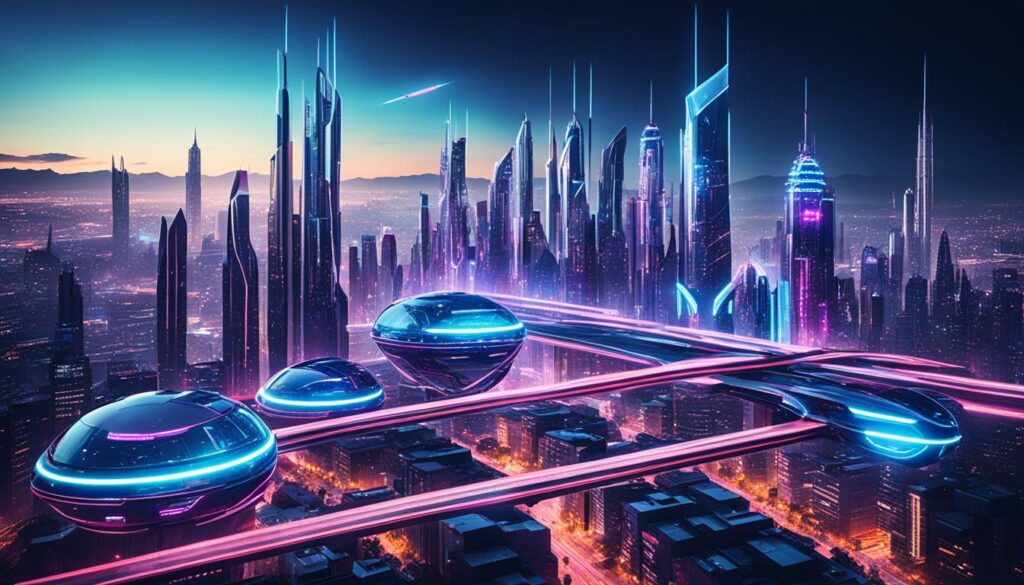Welcome to our exploration of the generative AI landscape. In this article, we will take a closer look at the revolutionary advancements in AI technology and how machine learning algorithms are driving this transformation. Generative AI has emerged as a powerful tool that is reshaping industries and pushing the boundaries of artificial intelligence.
Generative AI refers to the technology that enables machines to create new and original outputs based on patterns and data they have learned. It encompasses a wide range of applications, from generating realistic images and videos to producing human-like texts and music. By utilizing machine learning algorithms, generative AI systems can mimic the creative processes of the human mind, leading to exciting innovations.
AI technology, powered by generative models, has the potential to revolutionize various sectors. From healthcare and finance to entertainment and manufacturing, the possibilities are endless. Research and development in generative AI continue to expand, enabling breakthroughs in computer vision, natural language processing, and more.
Key Takeaways:
- Generative AI technology is revolutionizing industries with its ability to create new and innovative outputs.
- Machine learning algorithms play a crucial role in driving the development of generative AI systems.
- Generative AI has practical applications in computer vision, healthcare, finance, entertainment, and more.
- Deep learning models and advancements in natural language processing contribute to the capabilities of generative AI.
- Generative AI is continuously evolving, with ongoing research focusing on neural networks and their role in generating sophisticated outputs.
Understanding Generative AI Technology

In this section, we will delve deeper into the fascinating world of generative AI technology. Generative AI utilizes deep learning models and natural language processing advancements to create new and creative outputs, pushing the boundaries of artificial intelligence.
Deep learning models play a crucial role in the generative AI process. These models are designed to mimic the human brain, enabling machines to learn from vast amounts of data and generate outputs that are remarkably innovative and imaginative.
One of the key advancements in generative AI technology is natural language processing. This field focuses on improving machines’ ability to understand and process human language. With advancements in natural language processing, generative AI systems can now comprehend complex linguistic structures and generate text that is remarkably coherent and contextually appropriate.
“Generative AI technology has revolutionized industries by enabling the creation of novel and unique outputs. It opens up endless possibilities for innovation and creativity.” – Expert in Artificial Intelligence
Furthermore, generative AI technology has made significant strides in creating visually stunning outputs. Whether it’s generating lifelike images, producing realistic animations, or creating virtual worlds, deep learning models and natural language processing advancements have paved the way for visually engaging generative AI applications.
With generative AI technology, industries such as entertainment, design, and marketing can tap into the power of creativity and innovation to develop products and experiences that captivate audiences.
The Role of Deep Learning Models
Deep learning models form the core of generative AI technology. These models consist of multiple layers of artificial neural networks, enabling machines to analyze and learn complex patterns from large datasets.
Through a process known as unsupervised learning, deep learning models can autonomously learn from raw data without explicit training. This enables them to capture intricate patterns and generate outputs that exhibit a high level of creativity and authenticity.
Deep learning models can be trained on various types of data, including text, images, and audio. With access to diverse datasets, generative AI systems can produce outputs that mirror the characteristics and styles present in the training data.
Advancements in Natural Language Processing
Advancements in natural language processing have contributed significantly to the development of generative AI technology. Natural language processing algorithms can now understand and interpret the nuances of human language more accurately than ever before.
By leveraging techniques such as word embeddings and transformer models, generative AI systems can generate text that not only adheres to grammatical rules but also conveys semantic meaning. This has significant implications for applications such as chatbots, content generation, and language translation.
Through generative AI technology, machines are becoming increasingly proficient in understanding and producing human-like language, enabling more natural and engaging interactions between humans and AI systems.
| Advantages of Generative AI Technology | Applications |
|---|---|
| 1. Enables the creation of unique and innovative outputs | 1. Content generation |
| 2. Drives creativity and innovation in various industries | 2. Design and art |
| 3. Facilitates more natural and engaging human-AI interactions | 3. Virtual assistants and chatbots |
| 4. Expands the possibilities for personalized experiences | 4. Entertainment and gaming |
In conclusion, generative AI technology, powered by deep learning models and natural language processing advancements, is revolutionizing the way we create and interact with artificial intelligence. With its ability to generate new and creative outputs, generative AI holds tremendous potential for various industries and opens up exciting avenues for innovation and expression.
Applications of Generative AI in Various Industries

In today’s rapidly evolving technological landscape, generative AI is making significant strides in various industries. This cutting-edge technology is transforming computer vision and driving innovations that were once considered unimaginable. Let’s explore some of the remarkable applications of generative AI.
Computer Vision Advancements
Generative AI has revolutionized computer vision by pushing the boundaries of image recognition, object detection, and video synthesis. Through the use of sophisticated algorithms and deep learning models, generative AI systems can analyze and interpret visual data with remarkable accuracy. This has wide-ranging implications across industries such as healthcare, finance, and entertainment.
Healthcare
In the healthcare sector, generative AI is being utilized to enhance medical imaging and diagnostic processes. By leveraging advanced computer vision techniques, generative AI algorithms can analyze medical scans and identify anomalies with unparalleled precision. This allows healthcare professionals to make faster and more accurate diagnoses, leading to improved patient outcomes.
Finance
Generative AI is also making waves in the financial industry. By utilizing computer vision innovations, financial institutions can automate the analysis of complex financial data, such as financial statements and market trends. This enables professionals to make data-driven decisions and identify investment opportunities with greater efficiency.
Entertainment
The entertainment industry is harnessing the power of generative AI to create immersive visuals and captivating experiences. From video game development to special effects in movies, generative AI algorithms are enhancing the creative process and pushing the boundaries of visual storytelling. This technology allows artists and creators to bring their imagination to life in ways that were once unimaginable.
Summary
Generative AI is revolutionizing various industries through its applications in computer vision. From healthcare to finance and entertainment, this technology is driving innovations and transforming the way we perceive and interact with visual data.
With its remarkable ability to analyze, interpret, and generate visual content, generative AI continues to push the boundaries of what is possible. As advancements in generative AI technology continue to evolve, the potential for innovation and creative expression across industries is truly limitless.
| Industry | Application |
|---|---|
| Healthcare | Enhancing medical imaging and diagnostics |
| Finance | Automating financial data analysis |
| Entertainment | Pushing the boundaries of visual storytelling |
The Development of Neural Networks in Generative AI
In the exciting field of generative AI, neural networks play a pivotal role in the development and evolution of this technology. These networks are essential in generating complex and realistic outputs, such as images and music, that mimic human creativity. Through ongoing research and advancements, generative AI models are harnessing the power of neural networks to continuously improve performance and produce more sophisticated and refined results.
Neural networks in generative AI are designed to learn patterns and relationships from vast amounts of data. This learning process allows the network to understand the underlying structure of the data and generate new outputs with a similar style or characteristics.
One type of neural network commonly used in generative AI is the generative adversarial network (GAN). GANs consist of two neural networks: the generator and the discriminator. The generator network learns to create new data samples that resemble the training data, while the discriminator network assesses the generated samples in comparison to the real data. This adversarial training process enables the generator to continuously improve and produce outputs that are increasingly indistinguishable from real data.
Advancements in Neural Style Transfer
One fascinating application of neural networks in generative AI is neural style transfer. This technique allows for the transformation of ordinary images into artistic masterpieces by transferring the style of one image onto another. By leveraging convolutional neural networks (CNNs), neural style transfer algorithms are able to extract the content from one image and the style from another, and merge them to create unique and visually stunning results.
Furthermore, neural networks in generative AI have also been applied to the field of music generation. By training the network on a vast dataset of musical compositions, the network can learn the underlying patterns and structures of music and generate new pieces that are consistent with the learned style.
As the development of neural networks in generative AI continues to evolve, researchers are exploring innovative architectures and techniques to enhance the capabilities of generative AI models. From recurrent neural networks (RNNs) for sequential data generation to variational autoencoders (VAEs) for capturing the latent space of the data, these advancements are pushing the boundaries of what generative AI can achieve.
| Advantages of Neural Networks in Generative AI | Challenges of Neural Networks in Generative AI |
|---|---|
| Ability to generate complex and realistic outputs | Inherent biases in training data |
| Improved performance over time through adversarial training | Difficulty in controlling the output generation process |
| Flexibility to learn various data types and domains | Computational complexity and resource requirements |
As we continue to unlock the potential of neural networks in generative AI, the future holds exciting possibilities in the realms of creative content generation, design, and beyond. The combination of neural networks with other cutting-edge AI technologies will drive innovation and reshape industries, making generative AI a force to be reckoned with.
Conclusion
In conclusion, the generative AI landscape is revolutionizing various industries by pushing the boundaries of artificial intelligence. Through our exploration of this technology, we have gained an understanding of its underlying principles, including machine learning algorithms and deep learning models. This knowledge has allowed us to delve into the practical applications of generative AI, particularly in computer vision innovations.
Generative AI has opened up new possibilities in image recognition, object detection, and video synthesis, transforming industries such as healthcare, finance, and entertainment. With its ability to generate new and innovative outputs, generative AI holds tremendous potential for the future of technology.
One of the key components driving the advancements in generative AI is the development of neural networks. These networks play a crucial role in producing complex and realistic outputs, such as images and music. Ongoing research in this field is continually improving the performance and capabilities of generative AI models.
As we conclude our exploration of the generative AI landscape, it becomes clear that this technology is reshaping the way we interact with artificial intelligence. Through its transformative power and ability to generate creative outputs, generative AI is set to lead the way in the future of technology innovation.
FAQ
What is generative AI landscape?
Generative AI landscape refers to the current state and trends in the field of generative artificial intelligence. It encompasses the technologies, methodologies, and advancements that enable AI systems to generate new and creative outputs, such as images, music, and text.
How does generative AI technology work?
Generative AI technology utilizes deep learning models and machine learning algorithms to generate outputs that mimic or enhance human creativity. These models learn from large datasets and generate new outputs through a combination of probabilistic sampling and pattern recognition.
What are some advancements in natural language processing related to generative AI?
Natural language processing (NLP) advancements have significantly contributed to the progress of generative AI. NLP enables AI systems to understand and process human language more accurately, facilitating the generation of coherent and contextually relevant text outputs.
What are some applications of generative AI in different industries?
Generative AI finds practical applications in various industries. For example, in the healthcare sector, generative AI is used to create synthetic data for medical research and training AI models. In the finance industry, it aids in fraud detection and investment analysis. Additionally, generative AI powers computer vision innovations, enhancing image recognition and object detection capabilities.
How do neural networks contribute to generative AI development?
Neural networks play a vital role in generative AI by enabling the generation of complex and realistic outputs. They are used to model the underlying probability distributions of the data and generate outputs that match the desired characteristics. Ongoing research focuses on improving neural network architectures and training techniques to enhance the quality and diversity of generative AI outputs.
